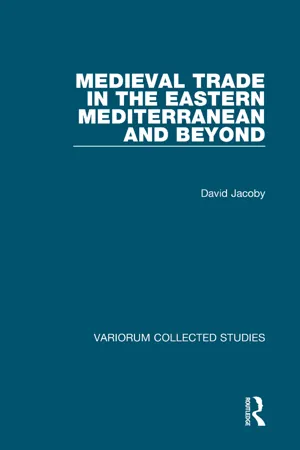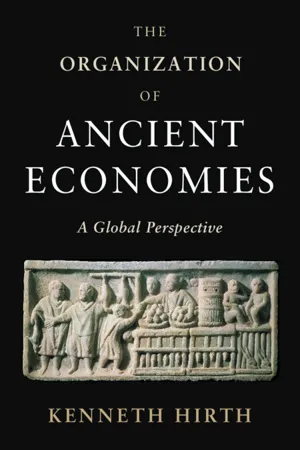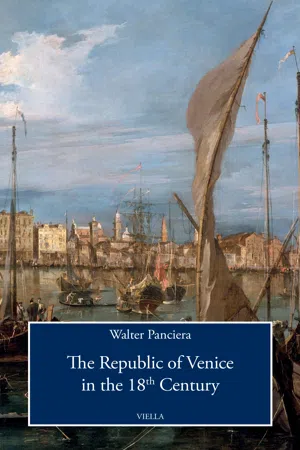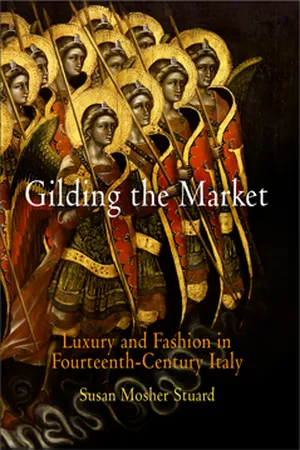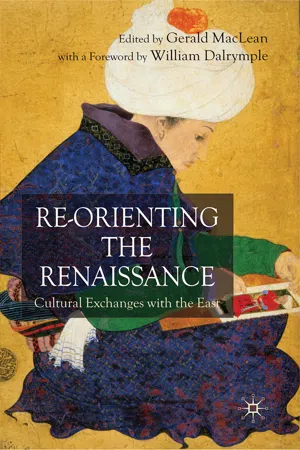History
Venetian Merchants
Venetian merchants were traders from the city of Venice who played a significant role in the Mediterranean and European trade during the Middle Ages and the Renaissance. They established extensive trade networks, particularly in luxury goods such as spices, silk, and precious metals. Their commercial activities contributed to the economic prosperity and cultural influence of Venice during this period.
Written by Perlego with AI-assistance
Related key terms
1 of 5
6 Key excerpts on "Venetian Merchants"
- David Jacoby(Author)
- 2017(Publication Date)
- Taylor & Francis(Publisher)
10From the 8th to 10th centuries, Venice concluded a series of treaties with the Lombard, Carolingian and Ottonian rulers successively controlling the neighbouring mainland. The purpose of these treaties was to ensure the preservation of the city’s virtual political independence, the Venetian diffusion of commodities imported by Venice from the eastern Mediterranean, both in northern Italy and beyond the Alps, and the orderly supplies of food, finished products and raw materials from the mainland. Both naval timber from the Alps floated down the rivers to the head of the Adriatic and iron from the area of Brescia in northern Italy and from Carinthia were of special importance in that context.11 The construction of ships for commercial and military use and the manufacture of weapons were key factors in Venice’s commercial and maritime expansion in the Adriatic and in the eastern Mediterranean. Venice boosted its naval power in the 9th century by the adoption of a Byzantine type of galley, technically superior to the ships sailing until then in the Adriatic. The Venetian chronicler Giovanni Diacono reports under the year 852 that two such ships, ‘called zalandriae in the Greek language’, in fact chelandie, were constructed by the doges, and that never before had that been achieved in Venice.12 Their construction implies the presence of Byzantine shipwrights in Venice or the apprenticeship of Venetian craftsmen in Byzantium. Naval timber also became an important export item to Muslim countries by the first half of the 10th- eBook - PDF
The Organization of Ancient Economies
A Global Perspective
- Kenneth Hirth(Author)
- 2020(Publication Date)
- Cambridge University Press(Publisher)
A merchant in general terms is an individual who participates and assists in resource provisioning within society 194 as an aspect of their livelihood. The merchant is an agent dedicated to the procurement, movement, and exchange of goods. The more vital resource movement is in meeting provisioning needs, the more important the role of merchant traders becomes within society. From a developmental perspective, merchants appeared when informal trading relationships and trade partner arrangements were insufficient for moving the quantity of goods needed or desired across the landscape. Likewise, an economic system can be said to increase in its level of commercialization as the number of goods moving through exchange rises in frequency and more people become dependent on exchange for the resources they consume. This chapter explores the role of merchants, the conditions that gave rise to their appearance, and some of the ways that merchant trade was organized and carried out in the ancient and premodern past. Merchants were important for the development of maritime societies such as Venice and Phoenicia. While a merchant could operate as an individual, they commonly self-organized and operated through a series of informal and voluntary institutions that helped them transact business and exchange goods both inside and outside their local, ethnic, and religious communities. WHO IS A MERCHANT? Webster’s New World Dictionary (1968) defines a merchant as an individual whose livelihood or business is buying and selling goods for profit – in short, a person involved in professional trade. While this definition was based on 20th-century views of the economy, it is simple, to the point, and applicable to a discussion of merchant behavior in the ancient world. - eBook - PDF
- Walter Panciera, Kalina Yamboliev(Authors)
- 2021(Publication Date)
- Viella Libreria Editrice(Publisher)
The urban economy thus, as a whole, remained lively and active, benefitting greatly from Venice’s favourable function as a port city, emporium and service centre, at least in the Adriatic and Italy. Its political class, although largely responsible for the ossification of the political-institutional structures, was actually (as it had always been) quite attentive to economic dynamics. It is true that the move towards modernisation was not welcomed by all, but in the 18 th century Venice’s mercantile and manufacturing sectors were elastic and dynamic enough to adapt. The remarkable variety of new products and goods recorded passing through the four city customs (the point of entry by land; that by sea, also called the Nuovo stallaggio ; the exit; and the Fontico , or the point of trade with the German world) are the main proof of Venice’s ongoing economic importance as a port and emporium for a large area. The incoming goods originated in and were bound for The Republic of Venice in the 18 th Century 56 a wide range of destinations and showed that the city was a central node within a network of international, not just regional, scale. For example, the Republic’s records of mercantile traffic list many of the major European ports not only for inbound but also for outbound goods, and especially for specialty items such as conterie or margarite , i.e. perforated glass beads that fed the African slave trade in Lisbon and Cadiz. The overall values recorded for merchant traffic on the Venetian market, which we have for at least part of the 18 th century, cannot reveal larger economic trends with great certainty, as they are indicative but not directly representative. However, the exchange sums recorded at over 13 million ducats per year (and, in one case, 18 million) were immense, equal to at least twice the revenue of the entire state budget. - eBook - PDF
Political Economies of Empire in the Early Modern Mediterranean
The Decline of Venice and the Rise of England, 1450–1700
- Maria Fusaro(Author)
- 2015(Publication Date)
- Cambridge University Press(Publisher)
Conversely, it could also be argued that this flexibility derived from the fact that the English were latecomers and needed to adjust not only to the requirements of the host countries but also to the ways of doing business which other foreign mercantile communities had developed there. In this way, the English quickly established themselves in the region, helped by the Venetian shipping crisis and by the Ottoman need for strategic goods and allies in Europe. Within this wider context, Venice represents a magnificent case study of English merchants abroad, as the attitude and behaviour of the mer- cantile community in Venice and its dependencies sheds light on a spe- cific phase of English trade expansion. During this first phase a highly structured organisation would adopt a very informal approach and a deceptively informal structure to penetrate deeply into the logic and the expertise of the host country. This allowed them to undermine quickly, from within, the formalised ways through which trade had traditionally been carried out. This behaviour proved to be the most effective way to trade with a sophisticated commercial culture like the Venetian one and was crucial to the reversal of fortunes between the two countries. This was 50 Frederic Lane has pointed up some economic functions of protection and ‘protection payments’ in an important series of articles, based on the experience of the medieval Mediterranean, but with a much wider relevance: Lane, Venice and History, especially 373–428. For the issue of protection costs, see also Curtin, Cross-Cultural Trade, 41–42; G. M. Anderson and R. D. Tollison, ‘Adam Smith’s Analysis of Joint-Stock Companies’, Journal of Political Economy, 90 (1982): 1237–1256; and their ‘Apologiae for Chartered Monopolies in Foreign Trade, 1600–1800’, History of Political Economy, 15 (1983): 549–566. English trading and living in Venice 211 - eBook - PDF
Gilding the Market
Luxury and Fashion in Fourteenth-Century Italy
- Susan Mosher Stuard(Author)
- 2011(Publication Date)
- University of Pennsylvania Press(Publisher)
In a real sense they evolved into merchandizers while disengaged from the production houses that had dominated medieval marketing heretofore. If money changers represented the low end of retailing luxuries to the Venetian public, then bankers exemplify the high end since they sometimes dealt in ready-made luxury goods intended for Europe’s wealthiest customers. More than exemplary record keeping and the accidents of preservation pertain when this study proposes that Venetian banking played a role in luxury marketing. Venice was known as a silver town because it had sustained its sil-ver grossi through imports of silver well into the fourteenth century, long after other Italian cities had ceased to mint their traditional large silver coins. Silver flowed into Venice from late medieval finds at Freiberg, Iglau, and Kutna Hora in rapid succession and from the newly opened mines of the Balkans, which constituted the last nearby and easily accessible silver strike of the medieval era. Additionally Venice imported a certain amount of bullion to sustain its own industry in luxury manufacture or for export to nearby towns. A loosely federated corps of long-distance merchants and bankers, Germans, Floren-tines, and Ragusans prominent among them, as well as Venice’s own bankers, staffed and managed this well-articulated supply system. Banking, bullion, and luxuries were linked historically. Merchant bankers from Lucca, the Ricciardi, Guinigi, Balbani, and Rapondi companies in partic-ular, had taken banking services north and advertised their readiness to do business with Lucca’s fine silks and jewels, illustrated beguilingly by merchant bankers’ own luxurious wardrobes. 8 Lombard and Tuscan merchant bankers followed this path and by the end of the thirteenth century spread their net-works from Ireland to east European principalities. Italian bankers to the great and powerful accepted pawns of jewels, gold, and silver for surety wherever they set up business. - eBook - PDF
Re-Orienting the Renaissance
Cultural Exchanges with the East
- G. Maclean(Author)
- 2005(Publication Date)
- Palgrave Macmillan(Publisher)
1 The Status of the Oriental Traveller in Renaissance Venice Deborah Howard Travel lore in its widest sense was an integral part of Venetian culture. Over the centuries, merchant handbooks, ambassadors' reports and pilgrim chronicles had recorded journeys made in the interests of trade, diplomacy and Christian devotion. Within Venice this body of knowl- edge circulated freely, orally and in manuscript form, but during the sixteenth century its dissemination was to be transformed by ambitious printing initiatives. A new genre, the printed anthology of travel narra- tives, gave added authority to geographical information and helped to shape the ways in which travellers were perceived. The accumulation of information about foreign parts was a crucial component of the education of Venice's mercantile nobility, who often travelled abroad at a very young age. For example, from the age of 17 to 22, the diarist Girolamo Priuli traded in London, where he claimed to have met King Henry VII on several occasions. 1 In his youth, Giosafat Barbaro, later to be Venetian ambassador in Persia, traded for 16 years based at Tana on the Black Sea. 2 The young Chioggian merchant Nicolo dei Conti spent 24 years in Cairo from 1415 to 1439, trading on behalf of his father in Egypt, Persia and India. 3 Alvise da Mosto, later a celebrated explorer, began his mercantile career in his teens as agent of the merchant Andrea Barbarigo from 1442 to 1448. 4 As he later explained: 'My whole idea was to spend my youth trading on every possible route, to accumulate facolta [a word comprising both authority and wealth], so that with the experience of the world I would be able to achieve every perfection of honour' (emphasis added). 5 For fifteenth-century Venetian Merchants, honour was inseparable from commercial success. In 1421 the future explorer Pietro Querini went to Flanders 'with the aim of acquiring something of what we men of the world crave insatiably, that is honour and riches' (emphasis 29
Index pages curate the most relevant extracts from our library of academic textbooks. They’ve been created using an in-house natural language model (NLM), each adding context and meaning to key research topics.
